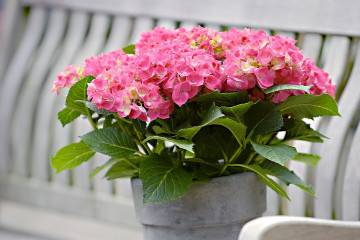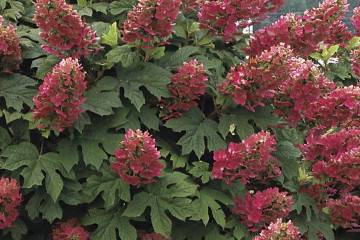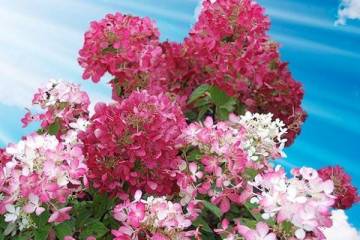Hydrangea tree Magical Pinkerbell
Content:
Treelike hydrangea was previously grown exclusively in royal gardens. Now the variety is popular with professional flower growers and amateurs. An unpretentious ornamental plant pleases with lush pink inflorescences from the first days of summer to mid-October.
The origin and appearance of the Magic Pinkerbell hydrangea
The Magic Pinkerbell is of Dutch selection and is considered a luxury variety. It was registered quite recently, in 2018.
Magical Pinkerbell tree hydrangea is a shrub 1.5 m in height and up to 2 m in width. The leaves are rounded with a jagged edge, 8-12 cm long, bright green in color. In autumn they turn yellow-green.
How it blooms
Inflorescences appear on the shoots of the current year, they are collected mainly from sterile flowers, up to 25 cm in diameter. Corollas are deep pink. The variety blooms from early summer until frost.
Transplanting hydrangea Magical Pinkerbell after purchase in open ground
It is better to plant a bush in early spring, before the plant picks up color, or in autumn after flowering ends.
What is needed for landing
Before planting a hydrangea, it is necessary to prepare a planting pit with a depth and diameter of at least 50 cm.
Choosing the best place
This variety thrives in the sun and partial shade. The soil is preferable fertile, well moistened and drained with an acidic reaction (pH 4.5-5).
A bush growing in the wrong place will not bloom and develop well.
Step-by-step planting process
To properly transplant a hydrangea, you need to take the following steps:
- Transfer the seedling to the prepared hole.
- Spread out the roots carefully.
- Cover the root system with soil.
- Water abundantly.
- Mulch with peat, bark, sawdust.
Reproduction of hydrangea Magic Pinkerbell
Hydrangeas reproduce well in vegetative ways.
Propagation by cuttings
This method is the easiest and most affordable.
Planting material is prepared in mid-July. Cuttings cut early in the morning from the lower branches of young plants, without signs of diseases and pests, will take root well.
Rooting is carried out as follows:
- After cutting, the shoots must be immediately put into water.
- Remove the top with a bud (if any) from the shoot.
- Divide the remaining shoot into segments with 2-3 pairs of leaves.
- Cut off the lower leaves from each cutting, and shorten the upper ones by a third.
- Place the cuttings in a rooting stimulant solution for 2 hours.
- Rooting is carried out in a moistened mixture of sand and peat (1: 2).
- Cover the rooted cuttings with a jar.
- Watering the cuttings is necessary 2-3 times a week.
- To withdraw the banks in a month.
Growing from cuttings
Hydrangea is propagated by layering in early spring.
Description of the procedure:
- Loosen and level the soil around the bush.
- From the base of the bush, lay radial grooves up to 4 cm deep.
- Place the nearest lower shoot in each groove and pin it.
- By the end of summer, 2-3 young plants are formed on each layer. When they reach a height of 15-20 cm, they need to be earthed up to form lateral roots.
- In October, young hydrangeas should be separated from the mother's shoots and buried in until spring.
Dividing the bush
Dividing a bush allows you to quickly get several mature bushes from one. The hydrangea is carefully dug up and the rhizome is divided into parts with a sharp pruner. The resulting cuttings are rooted in the same way as seedlings.
For your information! The bushes are usually divided in autumn.
Hydrangea Care Magic Pinkerbell
Caring for the latest generation of tree hydrangeas is easy. Simple agronomic techniques, performed accurately and on time, will provide excellent results.
Watering mode
Hydrangea tree Magical Pinkerbell loves moisture, drought is dangerous for her. You need to water with water at room temperature directly under the root.
During the summer heat, water every 2-3 days. With a normal amount of rain, the bushes will need to be watered 5 times per season.
Top dressing
To make the hydrangea bloom long and beautiful, it is fed at least 2 times a year. The first top dressing is in the spring before the buds appear, the second - in the fall after flowering. In the spring, fertilize with a urea solution (10 teaspoons per bucket of water). Each bush will need 3 buckets of mortar. In the fall, a complex fertilizer is applied.
There are many complex fertilizers for hydrangeas on the market. Using them will provide the bushes with the necessary nutrition.
Pruning
The variety tolerates pruning in early spring well. In the period from March to April, all dead, damaged shoots are removed. Good branches are shortened by lengths, keeping at least three buds each.
When pruning, it should be remembered that the inflorescences of a tree hydrangea, in contrast to paniculate, are formed on the shoots of the last year.
Features of care during flowering
During flowering, the plant needs regular, abundant watering. At the very beginning of the opening of the buds, you can feed the bushes with a solution of mullein or chicken droppings (1:10).
Features of care during the rest period
After the plant has bloomed, it is prepared for wintering:
- Dry inflorescences are removed.
- Huddle the base of the bush.
- Mulch the earth.
- Cover with spunbond on arches.
Preparing for winter
Even if the winter is predicted to be mild, it is better to play it safe and cover the bushes. This is usually done in October. The branches are tied, pressed to the ground, spunbond or lutrasil is used as a shelter, foliage is covered on top or spruce branches are laid.
Hydrangea Medzhikal has combined many of the positive characteristics of the members of its family, so this variety is becoming more and more popular and is often used in landscape design. It is suitable for growing in the climatic conditions of the Central zone and the north of Russia.


















